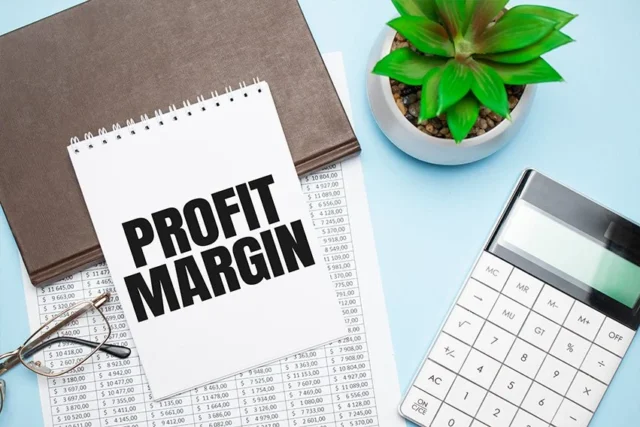
To effectively manage your business, you need to track your financial metrics, compare a wide range of ratios, and measure performance. One key metric you should know about to optimize sales is your business’s profit margin.
Calculating your business margin with a profit margin calculator will help you find the right sale price for your products or services to optimize your profits.
The profit margin is one of the easiest ways to track a business’s financial information. It is also one of finance and business’s most widely used financial metrics. Your business’s margin will be calculated at three levels, starting with the simplest level, gross profit, to the most significant margin, net profit. This article will cover the definition of profit margin and the easy ways to calculate the profit margin for your company with invoicing software.
What is a Company’s Profit Margin?
The profit margin is the percentage of your total revenue after paying for outgoing expenses. An optimum profit margin can improve the external perception of your business by investors and create more business opportunities. Knowledge of the profit

margin can help you track your company’s financial status and gives you the insight to make better future business decisions. With the insights provided, you can quickly follow and resolve issues about your financial information and other performance metrics like internal Rate of Return (IRR).
The profit margin summarises the profit percentage your business generates for each product or service. You can also calculate profit margin to get information on your company’s financial status for a particular period.
Ways to Calculate Your Profit Margins
The following are the critical margin ratios used for calculating the overall business margin:
Operational Gross profit margin
This measures the percentage of the total revenue your firm has left after the product’s costs have been deducted. It does not include other expenses such as warehousing, rent, raw materials, and utilities. It is how much you make after you have deducted all the running costs. Some may describe this as their take-home.
Since the operational gross profit margin accounts for income minus the cost of goods sold, it is one of the quickest and simplest ways to measure profitability.
Knowing your profit on each item can tell which items are making the most or least profit. Due to its peculiarity, it is used to calculate a single product or item’s profit margin, not the profit margin for the business itself. Therefore, it allows you to determine your total income on each service.
Your business needs this functional cost to know the true state of your business, and it’s financial health. So, it’s important that from time to time, you make your calculations.
To calculate this profit margin, subtracts your business’s operational costs from your revenue. Whatever the answer is, divide it by the total revenue and multiply by 100.
Operating profit margin
Operating profit margin (OPM) deducts all the operational, overhead, sales, administrative, and additional expenses your business needs to operate. It excludes non-operational fees, like debts. Using the operating profit margin, you can calculate your income after deducting operating costs.
The formula below will help you calculate your operating profit margin:
OPM = (Operating Income /Total Revenue) X 100.
Say your operational costs per quarter are $5,000, and the total revenue is $20,000; then your operating profit margin will be:
$5,000/$20,000 × 100 = 25%.
Net profit margin

This metric measures your company’s profitability and compares your total revenue with your net income. Your revenue is the total sum of all incoming revenue. The net income is the money your company has left after deducting outgoing expenses like operational costs, costs of packaging goods, cost of sold goods, and other related fees. These associated costs include transportation, debts, warehousing, taxes, and rent. You can also generate net income from other income sources outside of your sector, especially investments.
Your business’s net profit margin determines how profitable your company is and measures the total percentage of profit your firm generates compared with your total revenue. A study of your cumulative net profit over time will help you know if you’re making substantial business gains, which will also help you determine business goals.
Your firm’s average net profit margin depends on several factors. Some factors are your company’s location, the number of employees, and expatriates. It also includes the business’s nature, size, production method, and operating expenses. You can calculate your business’s net profit margin by following the steps below:
- Determine key margin ratios such as the cost of the products and other business running expenses
- Subtract the value of the total costs from the total revenue, and divide the amount by the revenue
- Multiply the above value by 100
For example, your company generates $4,000 as annual expenses while the revenue is $10,000.
Here’s how you would get the net profit margin:
$10,000 (revenue) – $4,000 (total expenses) = $6,000 (net profit)
$6,000 (net profit) / $10,000 (revenue) = 0.60
0.6 × 100 = 60% (net profit margin)
The above calculation also means that a 60% overall profit margin for your company means you earned a net income of $0.60 for each dollar of sales or product.
Calculate Profit Margins With Invoicing Software
To calculate your profit margins using invoicing software, you need to locate the margin calculator and follow the following steps:
- Enter the production costs for the product or services you sell.
- Input the operational and overhead expenses you pay to manufacture your products or provide services, such as rent, payment for equipment, and other additional costs.
- Enter how much profit you want to earn on each unit of your product or service.
- The software will generate the unit sale price, the profit on each unit, and the profit margin.
- The tool will help you know the optimal profit margin you should earn according to your expenses.
Other exciting things you can do with an invoicing software

While your invoicing software does an excellent job calculating profit margins, you can use it for many more exciting things. Here are a few things your invoicing software can also do
1. Create a wide range of professional invoice template
One of the most common reasons to use invoicing software is that it contains invoice templates you can choose from. Once selected, you can edit your preferred template to suit your business needs. You can either change the logo, personal details and other important information or personalize it by adding even more personal information.
2. Automated pricing
If you use a constant price for items, your invoicing software can automatically save them, so it pops up whenever you need to add the item’s price. This makes your invoicing faster, error-free and even more efficient. It also helps the creation of invoices, as with the prices popping up, the calculation is faster and smoother.
3. Automated invoicing
With your invoicing software, you can skip the operational process of sending invoices manually for return customers and customers who you bill per month, quarterly or even yearly. The invoicing software can be set up to send them a bill to request payments and remind them.
This can save your business running costs from forgetting to send invoices or even sending them late. The regimented sending of invoices also helps to smoothen the relationship between the customers and business owners.
4. Fast quote-to-invoice conversion
Your invoicing software can make your work even easier if you frequently send quotes. With invoicing software, you can easily convert a quote you’ve sent out before into an invoice. Many invoicing softwares can do this with a simple click. Since it takes the same format, it is easy for the customer to approve it quickly.
5. Easy Invoice accounting and taxing

An invoicing software can improve your business accounting. Since you can compute tax per invoice, you can contain your business’s financial information in your invoicing software. This way, once you create a new invoice, you automatically update your financial records and keep your accounting up-to-date. Since you can also calculate your profit margin, you will be able to tell the overall financial status of your business, and you know when you’re doing well or at risk.
With the automatic reconciliation feature of invoicing software, the invoice is reconciled immediately after a client responds to the invoice. This updates your records and helps you easily track payments and processes.
6. Easy invoicing (from your phone or tablet)
With the right invoicing software, you’ll never have to struggle with invoicing again. You can use invoicing software on your laptop, tablet, or mobile phone, and you can create, edit and even send invoices on the go.
7. Keep you updated on pending invoices
Since invoicing software automates reconciliation, it is easy to track invoices that have yet to be attended to. You can follow up when the invoice is overdue and when a reminder needs to be sent to the customer.








